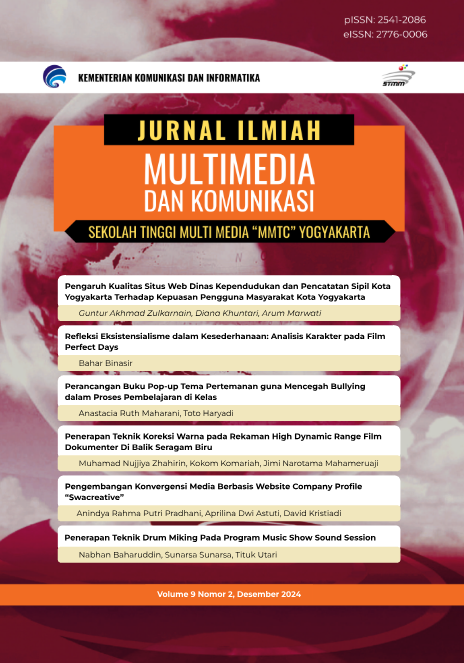Development Of Media Convergence Based On Company Profile Website “Swacreativeâ€
DOI:
https://doi.org/10.56873/jimk.v9i2.339Keywords:
media convergence, website, learnability, efficiencyAbstract
Companies need to present their identities, services, products and works to the public, using company profile websites. Some media can be converged into a company profile website to inform complete company information in an interesting way. However, in developing media convergence for company profiles based on websites, there are still many websites that have not implemented usability yet, so users face difficulties to get the information. Therefore, the development of a media convergence based on company profile website "Swacreative", implements the principle of usability with aspects of learnability and efficiency. Learnability and efficiency are applied to content layout, text types and colors, navigation features, photo and video display options. Usability testing was followed by 41 respondents. The test result shows that the website met the learnability and efficiency aspects. Majority of respondents agree that the website was easy to understand and to learn, the website's interactions were clear and easy to understand, the website's pages appeared without errors, the website's text types and colors were clearly readable and the website’s menu structures were easy to understand. Meanwhile, about the efficiency aspect of the website, the majority of respondents agree that the menus were displayed fast, navigation options were available, content design was structured, photo and video display options were available, and the website was able to be accessed using a multi web browser.Downloads
References
Geni, B. Y., Supriyadi, A., Khotimah, H., & Yanti, W. I. (2024). Rancang Bangun Company Profile Berbasis Web Menggunakan Metode Waterfall (Studi Kasus: APM Frozen Food). Jurnal RESTIKOM : Riset Teknik Informatika Dan Komputer, 6(1), Article 1. https://doi.org/10.52005/restikom.v6i1.260https://doi.org/10.1007/s41870-017-0048-1
Harsono, A. (2022). Konvergensi Jogja TV dan Media Sosial. Jurnal Ilmiah Multimedia Dan Komunikasi, 7(2), Article 2. https://doi.org/10.56873/jimk.v7i2.194
Hodrien, A., & Fernando, T. (2021, May 28). A Review of Post-Study and Post-Task Subjective Questionnaires to Guide Assessment of System Usability—JUX. JUX - The Journal of User Experience. https://uxpajournal.org/review-post-study-task-subjective-questionnaires-usability/
iframemultimedia.com. (2024). IFrame Multimedia | Professional Video Services. https://www.iframemultimedia.com/
Nielsen, J. (1993). Usability engineering. Academic press.
Nielsen, J. (1999). Designing web usability (1st ed.). New Riders Pub.
Nurlailah, E., & Wardani, K. R. N. (2023). Perancangan Website Sebagai Media Informasi Dan Promosi Oleh-Oleh Khas Kota Pagaralam. JIPI (Jurnal Ilmiah Penelitian Dan Pembelajaran Informatika), 8(4), Article 4. https://doi.org/10.29100/jipi.v8i4.4006
phoenixmultimedia.id. (2024). Front page—Phoenix. http://phoenixmultimedia.id/
Ramdhan, S., Tullah, R., & Janah, S. N. (2019). Iklan Animasi Stop Bullying Pada SD Negeri Cibadak II Berbasis Multimedia | Ramdhan | JURNAL SISFOTEK GLOBAL. 9(2). http://dx.doi.org/10.38101/sisfotek.v9i2.240
Sagar, K., & Saha, A. (2017). A systematic review of software usability studies. International Journal of Information Technology. https://doi.org/10.1007/s41870-017-0048-1
Downloads
Additional Files
Published
Issue
Section
License
Penulis yang menerbitkan artikel di jurnal ini menyetujui ketentuan berikut:
1. Hak Cipta tetap pada penulis dan memberikan hak kepada Jurnal Ilmiah Komunikasi dan Multimedia sebagai otoritas untuk menerbitkan artikel dengan Lisensi Creative Commons Atribusi 4.0 Internasional, yang memungkinkan artikel untuk dibagikan dengan sepengetahuan penulis artikel dan jurnal ini sebagai tempat publikasi.
2. Penulis dapat mendistribusikan publikasi artikelnya secara non-eksklusif (misalnya: pada repositori universitas atau buku) dengan pemberitahuan atau pengakuan publikasi di jurnal Option.
3. Penulis diperbolehkan memposting karyanya secara online (misalnya: di situs pribadi atau di repositori universitas) sebelum dan sesudah proses penyerahan (lihat Pengaruh Akses Terbuka)









